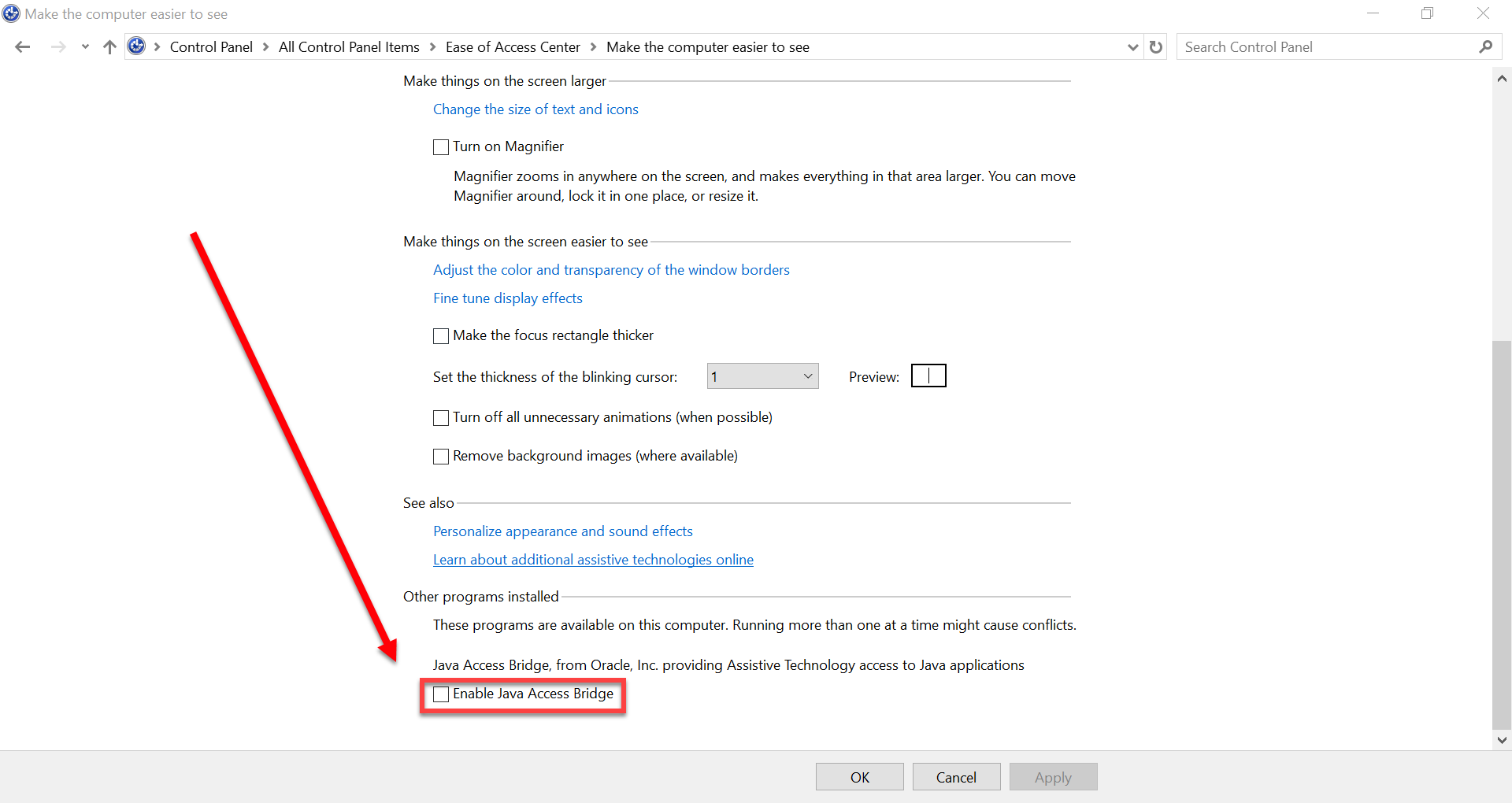This page presents the most frequent reasons for which the UiPath Extension for Java might not work properly, and how to solve these issues.
Check if the Java extension works properly
Check if UiPath Studio can retrieve valid Java selectors
To check if the extension is not working properly, open UIExplorer and try to select controls inside a Java app. If the entire window is selected, it means that the extension is not working properly.
If you can select controls, but their selectors look like
<wnd app=”...” /><ctrl role=”client” /> instead of <wnd app=”...” /><java role=”...” />, then the extension is not working properly.
Please note that the UiPath Extension for Java is compatible only with AWT apps (e.g. Java Swing, Oracle Forms, Fujitsu JBK), while SWT apps are automated with Active Accessibility. To detect the type of your Java application, check the cls attribute (window class name) in UiExplorer. The class name should be similar to SunAwtFrame or javax.swing.
Check if the extension files are loaded by the Java application
- Open Process Explorer.
- In the View menu, select Lower Pane View > DLLS, or press Ctrl+D. A panel is displayed in the lower part of the window.
- Select the process of your Java app and check if
UiPathJavaBridgeV8.dllorUiPathJavaBridgeV8_x64.dllare loaded by your Java app. - Check from what path the
java.dllmodule is loaded. A regular JRE has a path likeC:\Program Files (x86)\Java\jre1.8.0_xx\bin\java.dll. A custom JRE is usually located in the application folder.
Check if the extension files have been added to the JRE
- Using a text editor, such as Notepad++, open the
accessibility.propertiesfile, which is located in theC:\Program Files (x86)\Java\jre1.8.0_xx\libfolder. If the extension is properly installed, the file should containassistive_technologies=UiPath.UiPathBridge. - In the
C:\Program Files (x86)\Java\jre1.8.0_xx\lib\extfolder, you should find theUiPathBridge.jarfile. - In the
C:\Program Files (x86)\Java\jre1.8.0_xx\binfolder, you should findUiPathJavaBridgeV8.dllorUiPathJavaBridgeV8_x64.dll.
Note:
If any of the previous requirements are not met, you can try to reinstall the extension as explained above, or fix them manually.
Using Java 9+ JRE applications
Prior to Java 9, the Java Runtime Environment (JRE) included the jdk.attach module, which interacted with the UiPath Extension Java to generate appropriate selectors. Java 9+ only includes this module in the Java Development Kit (JDK).
Selectors are generated for any Java 9+ application opened with Java JDK. If, however, you need to create automation projects which interact with applications opened with Java JRE, you need to manually include the jdk.attach module in the target JRE.
Note:
For Java 9+, the UiPath Extension for Java works on Windows Enterprise and non-Enterprise editions with applications opened with Java JDK. For applications opened with Java JRE, the UiPath Extension for Java only works on non-Enterprise Windows editions.
Disabling the Java Access Bridge
Having Java Access Bridge enabled creates the accessibility.properties file in the current user's home directory which overwrites the accessibility bridge loaded by the default bridge. The solution is to disable the Java Access Bridge and remove the accessibility.properties file, as follows:
- Go to Control Panel > Ease of Access Center > Make the computer easier to see.
- Scroll to the bottom of the page to the Other programs installed section.
- Make sure the Enable Java Access Bridge box is not selected.

- If the Enable Java Access Bridge box was checked go to
C:\Users\current_user. - Delete the
.accessibility.propertiesfile.
Note:
If the Enable Java Access Bridge option is not visible, you need to reinstall or update Java.
Running UiPath Studio 2017.1 without SP1
Some Java web applications do not load properly when using UiPath Studio 2017.1 or lower. This occurs with JInitiator 1.3 and JRE 3. To prevent this you need to manually copy the xml-apis.jar file to the C:\Program Files (x86)\Java\jre1.8.0_xx\lib\ext folder or C:\Program Files (x86)\Java\JInitiator1.3.18\lib\ext folder.
Note:
This issue only occurs in Studio versions lower than 2017.1 SP1.
If the above information did not solve your issue, you can try getting additional information by viewing traces as explained here, and analyzing the errors thrown by the UiPath extension.
Updated 10 months ago